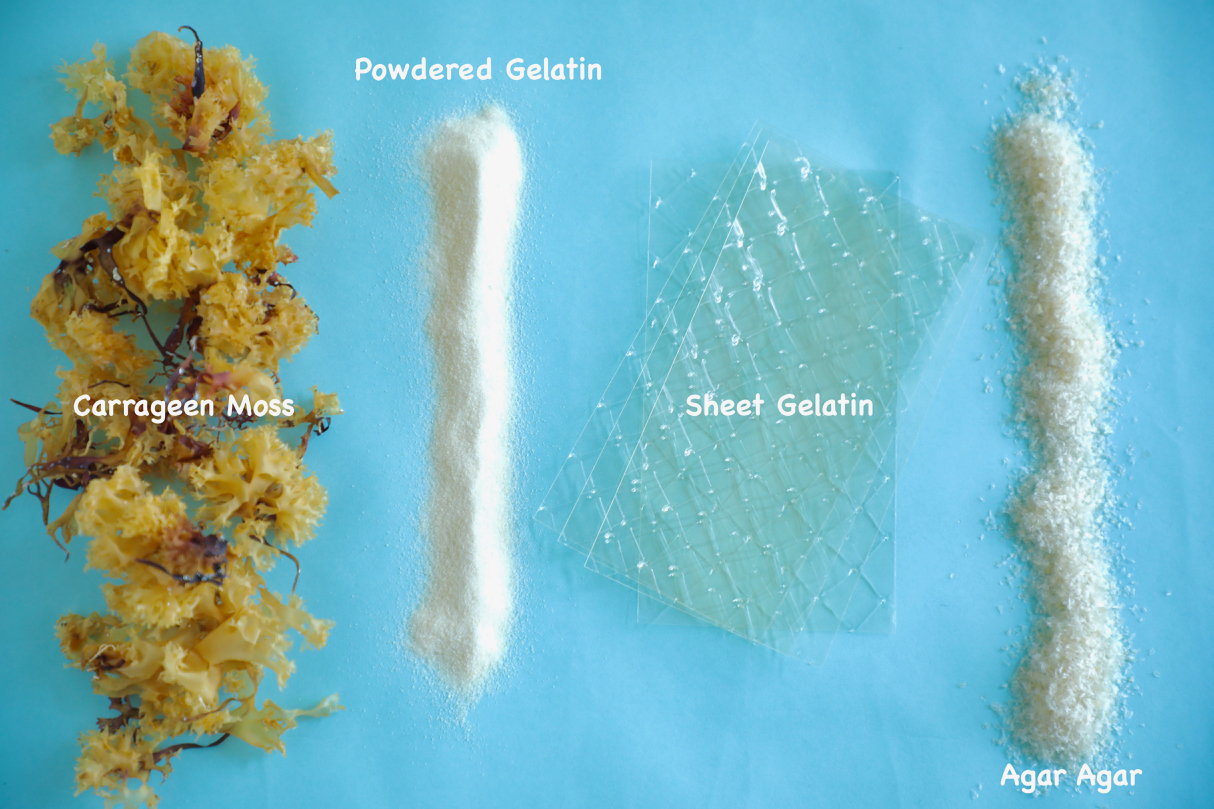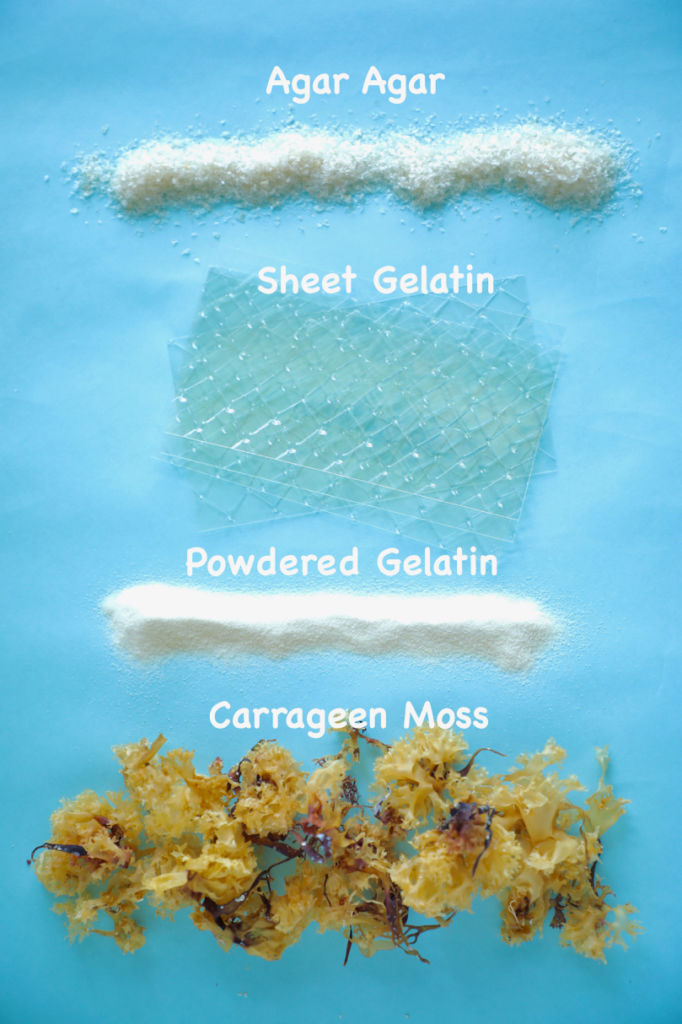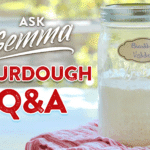
This post may contain affiliate links. Please see my full disclosure for details.
Hi Bold Bakers!
Since I get lots of questions regarding working with gelatin I wanted to give you the lowdown and address all things jelly. Whether you have worked with it before, just want to know how to properly measure it, or have shied away from it because you’re vegan or your diet is plant-based, this is the must-know when working with this ingredient. I’ll also explain how you can substitute it.
What is Gelatin?
There are two types of basic gelatin you may or may not have worked with — sheet gelatin, which is more commonly used amongst chefs as it creates a very clear gel, and powder gelatin. Both kinds are derived from animal collagen and both work very well for creating a set and firm jelly-like texture. I use gelatin in things like my Homemade Marshmallows, Coconut Panna Cotta, and homemade fruit jelly.
Though you may have never worked with it before, have no fear, because once you learn the tricks of the trade you will get no-fail results.
How to Bloom Gelatin
Whether you’re using sheet or powder gelatin you need to “bloom it,” or bring it to life in a way, before adding it into your recipes. What makes gelatin work is its ability to absorb and retain water. In order to allow the gelatin to absorb as much as possible, you simply sprinkle the powdered gelatin or add the required amount of sheet gelatin into a cold liquid and let it sit for 3 to 5 minutes.
Immediately you will notice that the little amount of liquid has “bloomed”, expanded, or in the case of sheet gelatin it has relaxed and softened. It is a good idea to use plain water for this step if you are adding to solid ingredients such as cheesecake or mousse. From here, drain off the excess water (for leaf gelatin) and heat, gently, to dissolve the gelatin to a liquid state. Allow it to cool before adding it to the rest of your recipe. If it’s too hot it can set in lumps when it comes in contact with your other, colder ingredients.
But, know this: you will want to avoid adding it to acidic juices often found in tropical fruits such as pineapple, kiwi fruit, or mango as the acids break down the structure created by the gelatin. Pectin is acid resistant, but it does not set as firm as gelatin. Pectin is what sets jams, a soft set.

What if I’m Vegan?
If you do not want to use animal-based gelatin there are other great options. The most popular types of vegetarian-based gels are Agar Agar or Kanten (the Japanese name for this), and Carrageenan, aka Irish moss. There are a number of types of Carrageenan too, all are extracted from a type of red seaweed that works similarly to their animal-based cousins. These plant-based gels have been used in Asian cuisine for generations and are widely available in health food stores, Asian markets, and of course, online. Working with Agar Agar and Carrageenan is very similar to working with regular gelatin, the difference is in the amount you use and the way in which you dissolve or “bloom” it before adding into your recipes.
Agar Agar: In order to get the full effect of Agar Agar it needs to be brought to a boil with water, from there as it cools it can be added to things and will turn into a lovely bouncy jelly. Agar sets more firmly than gelatin so recipes will be firmer and less creamy. It stays firm even in high temperatures so, on hot days, you don’t have to worry that it will collapse. Agar-Agar is available in several forms: bars, flakes, and powders. Powder is less expensive and the easiest to work with as it dissolves almost immediately so try to find that if you can. The bars and flakes can be powdered in a food processor to speed up blooming, flakes take longer to bloom than the powder.
Carrageenan: Carrageenan, also known as Irish moss, is a widely used food ingredient derived from red seaweed. Carrageenan shows up frequently in the ingredients section of food labels, where it can be found in ice cream, soups, sauces, yogurt, and even baby food. There are different forms of Carrageenan.
Iota-Carrageenan is a great thickening and gelling agent mostly used with fruits and dairy to form a heat-reversible gel. Iota-Carrageenan forms a soft gel, especially in the presence of calcium. This is largely used in manufacturing.
Kappa Carrageenan gels as it reacts with calcium or potassium salts. In manufacturing, it is chosen for different setting ability according to the ingredients used. Carrageenan shows stabilizing properties in the presence of milk proteins. People in the United States and elsewhere may notice that many heavy dairy creams and yogurt products available in supermarkets use carrageenan as a thickener.
Lambda is the only one of these soluble in cold water, the others need to be bloomed in a hot liquid. It is the only one which will not set firm, it is a thickener, often used in dairy products such as ‘Greek Style’ yogurt*. (Greek yogurt is a different thing, strained to set naturally). Lambda, therefore, is better used as a thickener of sorts and is commonly used to stabilize soups, ice cream, sauces and dressings and for adding body and thickness to liquid foods.
To decide which is best for your particular need read the labels in the store, or research the various versions of these products online. It is a learning curve!
Tips for Measuring Animal-Based Gelatin:
- One tablespoon of gelatin will set two cups of liquid
- One package of powdered gelatin is roughly equal to one tablespoon
- Four sheets of gelatin equal one tablespoon of powdered gelatin
Tips on Measuring Plant-Based Gelatin:
- 1 teaspoon gelatin = 1 teaspoon agar powder (this will set 1 cup of liquid)
- 1 teaspoon agar powder = 1 tablespoon agar flakes = 1/2 agar bar
- To set 1 cup of liquid, use 1 ounce dried carrageen
*Source: (https://www.carrageenans.com/pl/products)
Make These Recipes!
Don’t forget to follow Bigger Bolder Baking on Pinterest!







Will agar agar also becomes firm like gelatin when we leave it to set and also for agar agar should we use hot water or normal water?
How much water do you need per packet and can this be added to your ice cream recipe
Hi. Is China grass the same as agar agar?